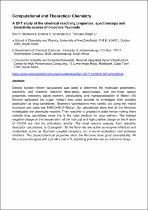 ResearchSpace
ResearchSpace
A DFT study of the chemical reactivity properties, spectroscopy and bioactivity scores of bioactive flavonols
JavaScript is disabled for your browser. Some features of this site may not work without it.
- ResearchSpace
- →
- Research Publications/Outputs
- →
- Conference Publications
- →
- View Item
| dc.contributor.author |
Akintemi, EO

|
|
| dc.contributor.author |
Govender, Krishna K

|
|
| dc.contributor.author |
Singh, T

|
|
| dc.date.accessioned | 2022-07-04T10:25:12Z | |
| dc.date.available | 2022-07-04T10:25:12Z | |
| dc.date.issued | 2022-02 | |
| dc.identifier.citation | Akintemi, E., Govender, K.K. & Singh, T. 2022. A DFT study of the chemical reactivity properties, spectroscopy and bioactivity scores of bioactive flavonols. <i>Computational and Theoretical Chemistry, 1210.</i> http://hdl.handle.net/10204/12450 | en_ZA |
| dc.identifier.issn | 2210-271X | |
| dc.identifier.issn | 1872-7999 | |
| dc.identifier.uri | https://doi.org/10.1016/j.comptc.2022.113658 | |
| dc.identifier.uri | http://hdl.handle.net/10204/12450 | |
| dc.description.abstract | Density function theory calculations was used to determine the molecular parameters, electronic and chemical reactivity descriptors, spectroscopy, and non-linear optical properties, electronic dipole moment, polarizability and hyperpolarizability of fifteen (15) flavonol aglycones (no sugar moiety) from plant sources to investigate their possible application as drug candidates. Geometry optimisations was carried out using the hybrid functional and basis set: M06-2X/6-31+G(d,p). Our calculations show that all the flavonols investigated are chemically reactive. Their reactivity is greatest in water hence making them suitable drug candidates since this is the ideal medium for drug delivery. The highest negative charge on the oxygen atom of the hydroxyl and high positive charge on the H atom of C5-OH are vital for antioxidant activity. The most reactive species, from reactivity descriptor calculations, is Gossypetin. All the flavonols are active as enzyme inhibitors and moderately active as G-protein-coupled receptors, ion channel modulators and protease inhibitors. The physicochemical properties show the flavonols have good bioavailability. All the compounds agree with Lipinski’s rule of 5, signifying potential use as oral active drugs. | en_US |
| dc.format | Abstract | en_US |
| dc.language.iso | en | en_US |
| dc.relation.uri | https://www.sciencedirect.com/science/article/pii/S2210271X22000718?via%3Dihub | en_US |
| dc.source | Computational and Theoretical Chemistry, 1210 | en_US |
| dc.subject | Bioactivity scores | en_US |
| dc.subject | Chemical reactivity properties | en_US |
| dc.subject | DFT | en_US |
| dc.subject | Flavonols | en_US |
| dc.subject | Spectroscopy | en_US |
| dc.title | A DFT study of the chemical reactivity properties, spectroscopy and bioactivity scores of bioactive flavonols | en_US |
| dc.type | Article | en_US |
| dc.description.pages | 12pp | en_US |
| dc.description.note | © 2022 Elsevier B.V. All rights reserved. Due to copyright restrictions, the attached PDF file only contains the abstract of the full text item. For access to the full text item, please consult the publisher's website: https://doi.org/10.1016/j.comptc.2022.113658 | en_US |
| dc.description.cluster | National Integrated Cyber InfraStructure | en_US |
| dc.description.impactarea | CHPC | en_US |
| dc.identifier.apacitation | Akintemi, E., Govender, K. K., & Singh, T. (2022). A DFT study of the chemical reactivity properties, spectroscopy and bioactivity scores of bioactive flavonols. <i>Computational and Theoretical Chemistry, 1210</i>, http://hdl.handle.net/10204/12450 | en_ZA |
| dc.identifier.chicagocitation | Akintemi, EO, Krishna K Govender, and T Singh "A DFT study of the chemical reactivity properties, spectroscopy and bioactivity scores of bioactive flavonols." <i>Computational and Theoretical Chemistry, 1210</i> (2022) http://hdl.handle.net/10204/12450 | en_ZA |
| dc.identifier.vancouvercitation | Akintemi E, Govender KK, Singh T. A DFT study of the chemical reactivity properties, spectroscopy and bioactivity scores of bioactive flavonols. Computational and Theoretical Chemistry, 1210. 2022; http://hdl.handle.net/10204/12450. | en_ZA |
| dc.identifier.ris | TY - Article AU - Akintemi, EO AU - Govender, Krishna K AU - Singh, T AB - Density function theory calculations was used to determine the molecular parameters, electronic and chemical reactivity descriptors, spectroscopy, and non-linear optical properties, electronic dipole moment, polarizability and hyperpolarizability of fifteen (15) flavonol aglycones (no sugar moiety) from plant sources to investigate their possible application as drug candidates. Geometry optimisations was carried out using the hybrid functional and basis set: M06-2X/6-31+G(d,p). Our calculations show that all the flavonols investigated are chemically reactive. Their reactivity is greatest in water hence making them suitable drug candidates since this is the ideal medium for drug delivery. The highest negative charge on the oxygen atom of the hydroxyl and high positive charge on the H atom of C5-OH are vital for antioxidant activity. The most reactive species, from reactivity descriptor calculations, is Gossypetin. All the flavonols are active as enzyme inhibitors and moderately active as G-protein-coupled receptors, ion channel modulators and protease inhibitors. The physicochemical properties show the flavonols have good bioavailability. All the compounds agree with Lipinski’s rule of 5, signifying potential use as oral active drugs. DA - 2022-02 DB - ResearchSpace DP - CSIR J1 - Computational and Theoretical Chemistry, 1210 KW - Bioactivity scores KW - Chemical reactivity properties KW - DFT KW - Flavonols KW - Spectroscopy LK - https://researchspace.csir.co.za PY - 2022 SM - 2210-271X SM - 1872-7999 T1 - A DFT study of the chemical reactivity properties, spectroscopy and bioactivity scores of bioactive flavonols TI - A DFT study of the chemical reactivity properties, spectroscopy and bioactivity scores of bioactive flavonols UR - http://hdl.handle.net/10204/12450 ER - | en_ZA |
| dc.identifier.worklist | 25591 | en_US |





